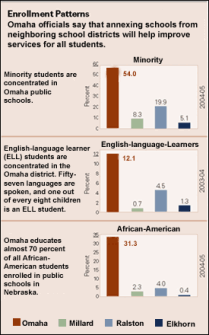A plan by the Omaha Public Schools to expand the district’s boundaries and annex schools and land within city limits from three neighboring suburban districts has triggered anger and controversy, straining relations among school officials and compelling the state governor to jump into the fray.
Omaha school officials say an 1891 state law mandates that as a city grows, so should its school system. “All schools erected or organized within the limits of cities of the metropolitan class shall be under the direction and control of the board of education,” one statute says.
Omaha has grown 22 percent between 1990 and 2004 to 409,000 residents. City boundaries have consequently expanded, spreading into some nearby suburban school districts, which have drawn largely middle-class white families from the increasingly diverse Omaha school system.
The urban district’s 12-member school board passed a unanimous resolution calling for the consolidation in early June. The plan would shift not just schools, but about 14,000 students and potentially millions of tax dollars to the Omaha district. Its leaders contend adding schools and resources would provide equal educational access for all students, not just for those in suburban enclaves.
OPS officials add that they will take the other districts to court if necessary. “This is a social-justice issue,” said John J. Mackiel, the Omaha schools superintendent. “A larger and broader tax base would provide comprehensive programs for all students.”
He added that the plan would not affect students or teachers in the day-to-day business of schools.
‘No Thanks’
Officials of the Millard, Ralston, and Elkhorn districts dispute the Omaha district’s interpretation of the law and say they will never agree to the plan. A Douglas County district court decision on Aug. 19 to allow the city of Omaha to annex nearby Elkhorn has not dampened their resolve.
Keith Lutz, the superintendent of the 21,000-student Millard district, which could lose 21 schools, the district administration center, and the district football stadium under the consolidation, called the plan akin to “a hostile takeover.”
“The attitude from our community is, ‘No thanks,’ ” he said.
Nebraska Gov. Dave Heineman in July sided with the suburban districts, arguing that forced consolidation wouldn’t work. He urged the Omaha district to rescind its plan.

“Voluntary consolidation is always preferred over forced consolidation,” the Republican governor said in a statement. However, he also brought the districts to the table twice this month to discuss the proposal and state policy allowing students to attend schools outside their home districts.
Meanwhile, state Sen. Ron Raikes, the chairman of the unicameral legislature’s education committee, is crafting a compromise plan to more equitably spread local funds among all Omaha-area districts.
So far, neither side has budged.
“Competition is good for education,” said Virginia Moon, the superintendent of the 3,100-student Ralston school system, which could lose four schools under Omaha’s plan. “But not this way.”
Omaha is wrestling with the often-divisive issue of race that other urban districts dealt with years ago, Mr. Mackiel said. He contends that implementation of Nebraska’s 1891 “one city, one school district” law stopped in 1971, when a mandatory integration policy began in the Omaha district, prompting many white families to move to the city’s suburbs. As a result, enrollment in the Omaha Public Schools plummeted from 64,000 to below 40,000—though enrollment has gradually increased since then.
“What we’re doing is bringing up matters that should have been dealt with 35 years ago,” Superintendent Mackiel said.
Now, the city school system wants to implement the statute partly because the provision almost got eliminated in the last legislative session, Mr. Mackiel said. In addition, one district would be more operationally efficient than five, he said.
Mr. Mackiel also criticized the state policy allowing students to attend schools in other districts although they live within the boundaries of the Omaha system.
The Omaha Public Schools, the largest system in the state, has a demographically diverse student population. Minority enrollment topped 50 percent in 2004-05, and one out of every eight students is not fluent in English.
Multiple Districts
Suburban district officials say the expansion proposal is a “sneak attack” and “a raid,” and they question exactly how the proposal would help all Omaha-area students, as leaders of the city schools insist it would.
“We are baffled, frankly,” said Superintendent Moon of the Ralston schools. “We spend less than Omaha Public Schools, and we’re using all the resources we have, so we don’t know how our resources will help them.”
Mr. Lutz, the Millard schools chief, also wonders about the logistics of paying for a $78 million school facility bond for Millard Public Schools that voters approved earlier this year, if its schools were incorporated into the Omaha system.
And Ms. Moon says there are decades of legislative precedent for the existence of multiple districts in a Nebraska city. “All of these districts existed 100 years ago,” she said. “We weren’t created in the 1970s.”




